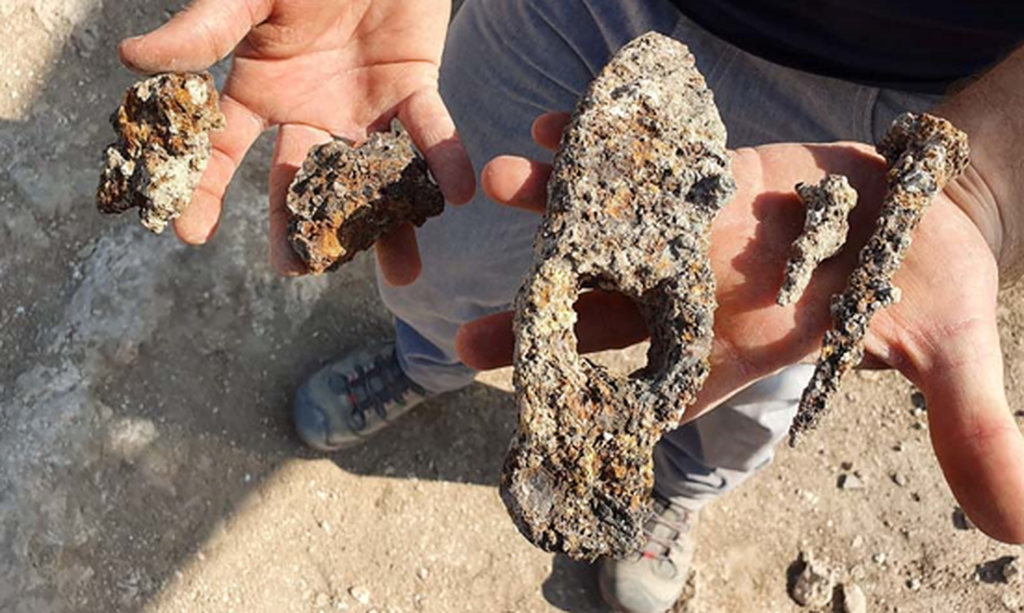The Byzantine period finds reveal that the inhabitants of ancient Usha manufactured iron tools.
By United With Israel Staff
Over the Sukkot holiday this month, a family from the Lower Galilee village of Tur’an dug up a 1,400-year-old iron hammer and nails at ancient Usha, near Kiryat Ata in northern Israel. The excavation is being run by the Israel Antiquities Authority.
The iron slag discovered lying adjacent to other tools reveals that the inhabitants of Usha manufactured iron tools.
“About 20 iron hammers are registered in the Israel Antiquities Authority records, only six of them from the Byzantine period,” according to Yair Amitzur and Eyad Bisharat, directors of the Usha excavation, which is part of the Sanhedrin Trail Project, on behalf of the Israel Antiquities Authority. “We already knew that the Usha settlers extensively manufactured glass vessels, since we found many wine glasses and glass lamps together with glass lumps that were the raw material. The discovery of the hammer, the nails and the adjacent iron slag teaches us that they also produced iron tools at the site.”
Other impressive finds at the ancient Jewish settlement include ritual baths (mikvahs), dating to the Roman and Byzantine periods, about 1,800 years ago. These were used, among other reasons, to produce olive oil and wine in a state of purity. The complex oil and wine presses that have been unearthed indicate that Usha inhabitants’ primary occupation and source of income were the large-scale processing of the olives and grapes that they cultivated on the surrounding Galilee hills.
The settlement of Usha is mentioned many times in Jewish sources from the Roman and Byzantine periods. It is described as the village where the Jewish people renewed the institution of the Sanhedrin, the great rabbinical court, after the destruction of the Temple in Jerusalem and after the failure of the Bar Kochba Revolt in 135 CE.
“The Sanhedrin was the central Jewish Council and Law Court, and it was headed by the president, Rabban Shimon ben Gamliel the Second, and then his son Rabbi Yehudah Hanasi,” both of whom presided in Usha, Amitzur explained.
“Here in Usha, the Rabbis of the Sanhedrin made decrees to enable the Jewish people to recover after the war against the Romans, and to reconstruct Jewish life in the Galilee,” he continued. “The Jewish sources mention that Rabbi Yitzhak Nafha was an inhabitant of Usha, and his name ‘Nafha’, meaning ‘the blower,’ indicates that he probably worked as a glass manufacturer. The many delicate wine glasses, glass lamps and glass lumps indicate that Usha inhabitants were proficient in the art of glassblowing. The ritual baths adjacent to the presses indicate that the Sanhedrin Sages paid particular attention to issues of ritual purity.”
The Israel Antiquities Authority sponsors community excavations year-round, mostly for youth and volunteers, in hopes of building a greater appreciation for Israel’s long and fascinating history and to build connections to the Holy Land’s cultural heritage. About 8,500 people participated in digs over Sukkot while more than 15,000 youth and families have participated in the educational opportunities offered at Usha over the past year.
MAKE THE LAND OF ISRAEL EVEN MORE BEAUTIFUL!
PLANT YOUR VERY OWN FRUIT TREES IN ISRAEL!
Farmers near the Gaza border lost family, friends and workers. Spring is here, and they desperately need help to replant the farms. Join us in blessing the People and Land of Israel.
“I will ordain My blessing for you…” (Leviticus 25:4)
